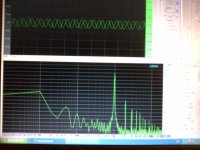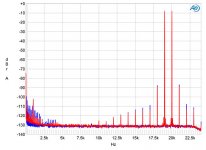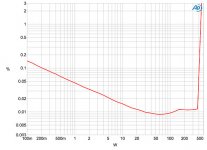Out of curiosity i made some listening tests and surprinsingly
when using a 1KHZ sine THD contents are clearly audibles at levels
higher than -60db , wich is 0.1%.
A screen of the THD distribution , quite tubish for a class AB
solid state...
when using a 1KHZ sine THD contents are clearly audibles at levels
higher than -60db , wich is 0.1%.
A screen of the THD distribution , quite tubish for a class AB
solid state...
Attachments
Last edited:
Hi,
At what SPL was the test made and what is HD level (per harmonic - not THD) of the transducers used at that level.
Ciao T
Out of curiosity i made some listening tests and surprinsingly when using a 1KHZ sine THD contents are clearly audibles at levels
higher than -60db , wich is 0.1%.
At what SPL was the test made and what is HD level (per harmonic - not THD) of the transducers used at that level.
Ciao T
A screen of the THD distribution , quite tubish for a class AB
solid state...
Do you mean "tubish" on onset of full power?
Tubish does not mean that. Tubish mean that when you decrease power higher order harmonics disappear, and at 1/10 of power only 2'nd and 3'rd are visible, and even they go down when you further decrease power.
I was just reading the historic series of articles by Jung et al. and subsequent letters exchanges from TAA about slew-induced distortion. Quite fascinating from both a technical and sociological point of view. So far I haven't found anyone mentioning that the reason the two-close-spaced-tone IM distortion test is poorly correlated with other measures of slew limiting effects is that, if the slew rates are symmetrical, the distortion is odd-order --- and thus the IM products, for example for a cubic nonlinearity, are at 2f1 - f2 and 2f2 - f1, i.e. on either side of the two stimulus frequencies.
When the slew rates are asymmetrical, then you will indeed get some even order including the simple difference frequency f2 - f1. But if that's the only thing you are measuring, trying to diagnose slewing problems, you will understandably be getting some poor correlations with, among other things, high frequency THD.
But surely someone discusses this sooner or later --- I just haven't seen it yet in TAA. But I have plenty of reading left to do.
When the slew rates are asymmetrical, then you will indeed get some even order including the simple difference frequency f2 - f1. But if that's the only thing you are measuring, trying to diagnose slewing problems, you will understandably be getting some poor correlations with, among other things, high frequency THD.
But surely someone discusses this sooner or later --- I just haven't seen it yet in TAA. But I have plenty of reading left to do.
Hi,
At what SPL was the test made and what is HD level (per harmonic - not THD) of the transducers used at that level.
Ciao T
Level is 12V Pk on a 4.7R + (0.5R//8R) load , the speaker is the 8R load,
this allow to reduce the SPL level while preserving about 16 damping factor.
The speakers are studio monitors Quested H108 , wich in this case were
driven with 1.2V Pk , about 100mW.
Their efficency is 90.5 db/1W/1m.
On the screen , the fundamental is at -5.83dB , very close to the -6dB line ,
while the line graduations are spaced with 6dB , wich imply that H2 is 46dB below the fundamental.
Do you mean "tubish" on onset of full power?
Tubish does not mean that. Tubish mean that when you decrease power higher order harmonics disappear, and at 1/10 of power only 2'nd and 3'rd are visible, and even they go down when you further decrease power.
The amp is close to clipping and as output level is reduced
high order harmonics decrease more than the fundamental
level variation.
Low order only THD is reached well before 1/10 of Pmax
despite the amp having meager NFB.
Last edited:
I was just reading the historic series of articles by Jung et al. and subsequent letters exchanges from TAA about slew-induced distortion. Quite fascinating from both a technical and sociological point of view. So far I haven't found anyone mentioning that the reason the two-close-spaced-tone IM distortion test is poorly correlated with other measures of slew limiting effects is that, if the slew rates are symmetrical, the distortion is odd-order --- and thus the IM products, for example for a cubic nonlinearity, are at 2f1 - f2 and 2f2 - f1, i.e. on either side of the two stimulus frequencies.
When the slew rates are asymmetrical, then you will indeed get some even order including the simple difference frequency f2 - f1. But if that's the only thing you are measuring, trying to diagnose slewing problems, you will understandably be getting some poor correlations with, among other things, high frequency THD.
But surely someone discusses this sooner or later --- I just haven't seen it yet in TAA. But I have plenty of reading left to do.
Yes. Also, when sidebands are of different highs that means phase intermodulation.
Signal generators and oscilloscope still are nice tools, if to know how to use them properly. Like, a flashlight is good tool when you can guess where you could drop that car keys on dark parking lot.
The amp is close to clipping and as output level is reduced
high order harmonics decrease more than the fundamental
level variation.
Low order only THD is reached well before 1/10 of Pmax
despite the amp having meager NFB.
So, on 1/10 of Pmax it is way below 0.1%, and low order.
I doubt it will be audible, even if on peaks it is as pictured.
Thorsten asked precisely right question, about level of loudness. Dynamics matters more than static numbers when they are so small.
So, on 1/10 of Pmax it is way below 0.1%, and low order.
I doubt it will be audible, even if on peaks it is as pictured.
Thorsten asked precisely right question, about level of loudness. Dynamics matters more than static numbers when they are so small.
Indeed , with a musical signal , even the screened high THD
would be inaudible given the huge amount of harmonics
produced by instruments.
I did the test at low SPL , agree though that perception
is different when reaching tympani compression....
Hi,
So the SPL is around 80dB at 1m and probably lower than that at listening distance. The human hearing becomes more sensitive at these fairly low levels.
Speaker HD would arguably be low.
So it is not 0.1% THD, but over 0.5%, a difference of more than 14dB compared to your claim.
Can 0.5% THD with harmonic structure like you show be heard on an 80dB SPL pure tone? Yes, very likely.
Now can 0.1% almost pure 2nd HD be heard at 108dB SPL with pure tones?
Ciao T
Level is 12V Pk on a 4.7R + (0.5R//8R) load , the speaker is the 8R load, this allow to reduce the SPL level while preserving about 16 damping factor.
The speakers are studio monitors Quested H108 , wich in this case were
driven with 1.2V Pk , about 100mW.
Their efficency is 90.5 db/1W/1m.
So the SPL is around 80dB at 1m and probably lower than that at listening distance. The human hearing becomes more sensitive at these fairly low levels.
Speaker HD would arguably be low.
On the screen , the fundamental is at -5.83dB , very close to the -6dB line ,
while the line graduations are spaced with 6dB , wich imply that H2 is 46dB below the fundamental.
So it is not 0.1% THD, but over 0.5%, a difference of more than 14dB compared to your claim.
Can 0.5% THD with harmonic structure like you show be heard on an 80dB SPL pure tone? Yes, very likely.
Now can 0.1% almost pure 2nd HD be heard at 108dB SPL with pure tones?
Ciao T
Which slew rate?
Voltage, as V/uS?
Or current, as A/uS?
All too often, and very typical of particularly Japanese gear, while the voltage slew rate can even be outstanding, the current slew rate is something they know nothing about, and if even mentioned, you are expected to hara kiri at once.
Others, such as for example SAE, did quote it as 20 A/uS for their mammoth 500 WPC amp.
Voltage, as V/uS?
Or current, as A/uS?
All too often, and very typical of particularly Japanese gear, while the voltage slew rate can even be outstanding, the current slew rate is something they know nothing about, and if even mentioned, you are expected to hara kiri at once.
Others, such as for example SAE, did quote it as 20 A/uS for their mammoth 500 WPC amp.
Hi,
So the SPL is around 80dB at 1m and probably lower than that at listening distance. The human hearing becomes more sensitive at these fairly low levels.
Speaker HD would arguably be low.
Also human listening is more linear at such levels , tympani
compression is low.
So it is not 0.1% THD, but over 0.5%, a difference of more than 14dB compared to your claim.
Can 0.5% THD with harmonic structure like you show be heard on an 80dB SPL pure tone? Yes, very likely.
Now can 0.1% almost pure 2nd HD be heard at 108dB SPL with pure tones?
Ciao T
Yes but it s audible with values as low as 0.1% , particularly
if there s significant H3 , H5.
One who is musician will notice the presence of a fifth
and a third very clearly, while a not musicaly trained ear will
still have the impression of a sound that sound...false !!....
The H2 and H4 are more subtle in that they are octaves
of the fundamental , but basicaly their effect , also audible
at relatively low level , is to add some kind of punch to the sound,
as would do an exciter.
The mix of all these even and odd harmonics render the sound
quite unpleasant.
All this is with a 1KHZ sine as signal , so all else being equal ,
this must be kept in this context as musical signals are a different
matter in respect of added harmonics tolerance and audibility.
Yeah, but mechanical hysteresis of the ear-bones is prevalent.Also human listening is more linear at such levels , tympani compression is low.
The ear is a better sensor at medium-high average levels. Actually this is indirect reflected in any audiometry chart.
Last edited:
What puzzles me is who might be left in the vast Harman empire who knows how to design non-switching amps. The company has been IMO on a downward spiral of truly ghastly proportions, with the occasional glimmer of hope here and there, since a CEO with no audio experience whatsoever took over, moved corporate HQ to Connecticut and replaced all of his direct reports. The company has since shed a plethora of talented people. Whatever issues one may have had with Sidney Harman, people used to say we could do a lot worse. They are being vindicated in that judgment! So it goes. Of course we have Bose and Monster et al. to compare to, which makes the situation seem less bad I suppose.
Looks like JA was impressed ...
"Harman Kardon's HK 990 is a powerhouse of an amplifier with, overall, superb measured performance. While high-quality outboard phono stages and D/A processors will give better measured performance than the HK 990's equivalents, there is no other sign of any aspect of its performance having been compromised to include so many versatile features. I am impressed."
—John Atkinson
Attachments
Hi,
Again, 0.1%3rd (or worse 5th) Harmonic at 80dB SPL can be readily audible with pure tones.
Your initial post made it seem that you claimed 0.1% THD of the 2nd Harmonics dominant spectrum you showed was readily audible with pure tones. Even at 80dB SPL I would somewhat doubt that.
Ciao T
PS, what is the HD level of your speakers?
Yes but it s audible with values as low as 0.1% , particularly if there s significant H3 , H5.
Again, 0.1%3rd (or worse 5th) Harmonic at 80dB SPL can be readily audible with pure tones.
Your initial post made it seem that you claimed 0.1% THD of the 2nd Harmonics dominant spectrum you showed was readily audible with pure tones. Even at 80dB SPL I would somewhat doubt that.
Ciao T
PS, what is the HD level of your speakers?
Hi,
Again, 0.1%3rd (or worse 5th) Harmonic at 80dB SPL can be readily audible with pure tones.
Your initial post made it seem that you claimed 0.1% THD of the 2nd Harmonics dominant spectrum you showed was readily audible with pure tones. Even at 80dB SPL I would somewhat doubt that.
Ciao T
PS, what is the HD level of your speakers?
I will do a test dedicated to even harmonics to have
some clues about it...
As for my speaker s HD content , i dont know since i ve no
accurate enough microphone to perform a valuable measurement.
I dont use DIY speakers , i just bought them used in a studio ,
for a mere 250 euros for the pair....
Monitoring systems - studio speakers. Welcome to the world of QUESTED
http://www.quested.com/data-sheets/H108.pdf
Last edited:
Yeah, but mechanical hysteresis of the ear-bones is prevalent.
The ear is a better sensor at medium-high average levels. Actually this is indirect reflected in any audiometry chart.
At what level is "medium" ??...
At high average level i suppose that you ll have to take account
of the very same ear-bones own resonnances that are distinct
of the listened signal, hence discrimination capability may not be as good.
For the test i did , it was about 80dB SPL , with THD contents
trimed from below 0.1% to 0.5% , wich render them clearly audible
thanks to the ear not being saturated by the fundamental.
Status report on the DH-120 saga.
With the repairs done, it sounded OK. About where I started which is below par to the Rotels and Parasound. Parts came so I went to bench it and get good before measurements. One side I had only 25mA bias. The VAS CCS was not working correctly. Fixed that and changed the fixed resistors in the spreader to get a full 110mA on both sides. Adjusted the "symmetry" for equal swing on the scope. Depending on temp, this puppy is barely stable. It was OK at 90mA bias, but at 110, when cold it would ring about 900Khz on the positive side for a few seconds if you put in a 10K square wave at 1V p-p. Gain is not quite the same right to left, 19V on left, 20 on right with 1V RMS 20K sine wave. Full power Bandwidth seems to be above 30K with a 8 Ohm resistor load. It is less stable with no load. I put in the corrected gate resistors as per the changed outputs. Made it even touchier, but the square wave was a shade more square. Think I'll sleep on it and decide if I am going to continue beating the original design into submission, or if I should jump to the end game as modeled in SPICE and then fix the ugly realities I expect. Sitting here, I think I just came up with a way to get the gate resistors right on the sockets and not break them. This is not really an easy layout to work on.
With the repairs done, it sounded OK. About where I started which is below par to the Rotels and Parasound. Parts came so I went to bench it and get good before measurements. One side I had only 25mA bias. The VAS CCS was not working correctly. Fixed that and changed the fixed resistors in the spreader to get a full 110mA on both sides. Adjusted the "symmetry" for equal swing on the scope. Depending on temp, this puppy is barely stable. It was OK at 90mA bias, but at 110, when cold it would ring about 900Khz on the positive side for a few seconds if you put in a 10K square wave at 1V p-p. Gain is not quite the same right to left, 19V on left, 20 on right with 1V RMS 20K sine wave. Full power Bandwidth seems to be above 30K with a 8 Ohm resistor load. It is less stable with no load. I put in the corrected gate resistors as per the changed outputs. Made it even touchier, but the square wave was a shade more square. Think I'll sleep on it and decide if I am going to continue beating the original design into submission, or if I should jump to the end game as modeled in SPICE and then fix the ugly realities I expect. Sitting here, I think I just came up with a way to get the gate resistors right on the sockets and not break them. This is not really an easy layout to work on.
A power house for sure .....2 ohm ...
I'll have to find out who did that.
- Status
- Not open for further replies.
- Home
- Member Areas
- The Lounge
- Sound Quality Vs. Measurements


